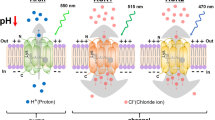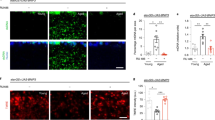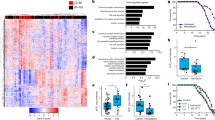Abstract
Mitochondrial dysfunction plays a central role in aging but the exact biological causes are still being determined. Here, we show that optogenetically increasing mitochondrial membrane potential during adulthood using a light-activated proton pump improves age-associated phenotypes and extends lifespan in Caenorhabditis elegans. Our findings provide direct causal evidence that rescuing the age-related decline in mitochondrial membrane potential is sufficient to slow the rate of aging and extend healthspan and lifespan.
This is a preview of subscription content, access via your institution
Access options
Access Nature and 54 other Nature Portfolio journals
Get Nature+, our best-value online-access subscription
$29.99 / 30 days
cancel any time
Subscribe to this journal
Receive 12 digital issues and online access to articles
$119.00 per year
only $9.92 per issue
Buy this article
- Purchase on Springer Link
- Instant access to full article PDF
Prices may be subject to local taxes which are calculated during checkout


Similar content being viewed by others
Data availability
All other data supporting the findings of this study are available from the corresponding author upon reasonable request. The mass spectrometry proteomics data have been deposited to the ProteomeXchange Consortium (http://proteomecentral.proteomexchange.org) via the PRIDE27,28,29 partner repository with the dataset identifier PXD033901.
References
Lopez-Otin, C. et al. The hallmarks of aging. Cell 153, 1194–1217 (2013).
Berry, B. J. & Kaeberlein, M. An energetics perspective on geroscience: mitochondrial protonmotive force and aging. Geroscience 43, 1591–1604 (2021).
Hughes, A. L. & Gottschling, D. E. An early age increase in vacuolar pH limits mitochondrial function and lifespan in yeast. Nature 492, 261–265 (2012).
Hughes, C. E. et al. Cysteine toxicity drives age-related mitochondrial decline by altering iron homeostasis. Cell 180, 296–310 (2020).
Mansell, E. et al. Mitochondrial potentiation ameliorates age-related heterogeneity in hematopoietic stem cell function. Cell Stem Cell https://doi.org/10.1016/j.stem.2020.09.018 (2020).
Ziegler, D. V. et al. Calcium channel ITPR2 and mitochondria-ER contacts promote cellular senescence and aging. Nat. Commun. 12, 720 (2021).
Martínez-Reyes, I. & Chandel, N. S. Mitochondrial TCA cycle metabolites control physiology and disease. Nat. Commun. 11, 102 (2020).
Waschuk, S. A. et al. Leptosphaeria rhodopsin: bacteriorhodopsin-like proton pump from a eukaryote. Proc. Natl Acad. Sci. USA 102, 6879–6883 (2005).
Berry, B. J. et al. Optogenetic control of mitochondrial protonmotive force to impact cellular stress resistance. EMBO Rep. 21, e49113 (2020).
De Magalhaes Filho, C. D. et al. Visible light reduces C. elegans longevity. Nat. Commun. 9, 927 (2018).
Busack, I. et al. The OptoGenBox – a device for long-term optogenetics in. J. Neurogenet. 34, 466–474 (2020).
Rea, S. L., Ventura, N. & Johnson, T. E. Relationship between mitochondrial electron transport chain dysfunction, development, and life extension in Caenorhabditis elegans. PLoS Biol. 5, e259 (2007).
Ventura, N., Rea, S. L. & Testi, R. Long-lived C. elegans mitochondrial mutants as a model for human mitochondrial-associated diseases. Exp. Gerontol. 41, 974–991 (2006).
Yang, W. & Hekimi, S. A mitochondrial superoxide signal triggers increased longevity in Caenorhabditis elegans. PLoS Biol. 8, e1000556 (2010).
Ristow, M. & Schmeisser, S. Extending life span by increasing oxidative stress. Free Radic. Biol. Med 51, 327–336 (2011).
Lee, S. S. et al. A systematic RNAi screen identifies a critical role for mitochondria in C. elegans longevity. Nat. Genet. 33, 40–48 (2003).
Glenn, C. F. et al. Behavioral deficits during early stages of aging in Caenorhabditis elegans result from locomotory deficits possibly linked to muscle frailty. J. Gerontol. A Biol. Sci. Med Sci. 59, 1251–1260 (2004).
Pelicioni, P. H. S. et al. Mild and marked executive dysfunction and falls in people with Parkinson’s disease. Braz. J Phys. Ther. https://doi.org/10.1016/j.bjpt.2020.11.005 (2020).
Ibanez-Ventoso, C. et al. Automated analysis of C. elegans swim behavior using CeleST software. J. Vis. Exp. https://doi.org/10.3791/54359 (2016).
Burkewitz, K. et al. Neuronal CRTC-1 governs systemic mitochondrial metabolism and lifespan via a catecholamine signal. Cell 160, 842–855 (2015).
Philip, N. S. et al. Mos1 element-mediated CRISPR integration of transgenes in Caenorhabditis elegans. G3 9, 2629–2635 (2019).
Paix, A. et al. High efficiency, homology-directed genome editing in Caenorhabditis elegans using CRISPR-Cas9 ribonucleoprotein complexes. Genetics 201, 47–54 (2015).
Kwon, Y. J. et al. High-throughput biosorter quantification of relative mitochondrial content and membrane potential in living Caenorhabditis elegans. Mitochondrion 40, 42–50 (2018).
Tsalik, E. L. & Hobert, O. Functional mapping of neurons that control locomotory behavior in Caenorhabditis elegans. J. Neurobiol. 56, 178–197 (2003).
Berry, B. J. et al. Neuronal AMPK coordinates mitochondrial energy sensing and hypoxia resistance in C. elegans. FASEB J. 34, 16333–16347 (2020).
Cox, J. et al. Accurate proteome-wide label-free quantification by delayed normalization and maximal peptide ratio extraction, termed MaxLFQ. Mol. Cell Proteom. 13, 2513–2526 (2014).
Perez-Riverol, Y. et al. The PRIDE database resources in 2022: a hub for mass spectrometry-based proteomics evidences. Nucleic Acids Res. 50, D543–D552 (2022).
Deutsch, E. W. et al. The ProteomeXchange consortium in 2020: enabling ‘big data’ approaches in proteomics. Nucleic Acids Res. 48, D1145–D1152 (2020).
Perez-Riverol, Y. et al. PRIDE inspector toolsuite: moving toward a universal visualization tool for proteomics data standard formats and quality assessment of ProteomeXchange datasets. Mol. Cell Proteom. 15, 305–317 (2016).
Acknowledgements
B.J.B. is supported by the Biological Mechanisms for Healthy Aging Training Grant National Institutes of Health (NIH)/National Institute on Aging T32 AG066574 and by NIH/NIA grant P30AG013280 to M.K. A.P.W. is supported by NIH grants (R01 NS092558 and R01 NS115906). S.P. is supported by a Deutsche Forschungsgemeinschaft grant (458246576) by two Longevity Impetus grants from Norn Group. We also acknowledge the W. M. Keck Microscopy Center and the Keck Center Manager and N. Peters for confocal microscopy access and training (NIH S10 OD016240).
Author information
Authors and Affiliations
Contributions
B.J.B., M.K., S.P. and A.P.W. designed the research. B.J.B. performed the lifespans, imaging and analysis, healthspan experiments and data analysis. A.V. carried out lifespan and respiration experiments. A.M.E. carried out lifespan experiments. C.M. and C.L. carried out mass spectrometry. B.J.B. wrote the manuscript with input from M.K., S.P. and A.P.W.
Corresponding authors
Ethics declarations
Competing interests
B.J.B., S.P. and A.P.W. are listed as inventors on a patent application based on some of the work described here. The remaining authors declare no competing interests.
Peer review
Peer review information
Nature Aging thanks Liza Pon, Alex Soukas, and the other, anonymous, reviewer(s) for their contribution to the peer review of this work.
Additional information
Publisher’s note Springer Nature remains neutral with regard to jurisdictional claims in published maps and institutional affiliations.
Supplementary information
Supplementary Information
Supplementary Figs. 1–6 and Supplementary Tables 1–3.
Supplementary Data 1
Source data for Supplementary Fig. 2.
Supplementary Data 2
Source data for Supplementary Fig. 3.
Supplementary Data 3
Source data for Supplementary Fig. 5.
Supplementary Data 4
Source data for Supplementary Fig. 6.
Rights and permissions
Springer Nature or its licensor (e.g. a society or other partner) holds exclusive rights to this article under a publishing agreement with the author(s) or other rightsholder(s); author self-archiving of the accepted manuscript version of this article is solely governed by the terms of such publishing agreement and applicable law.
About this article
Cite this article
Berry, B.J., Vodičková, A., Müller-Eigner, A. et al. Optogenetic rejuvenation of mitochondrial membrane potential extends C. elegans lifespan. Nat Aging 3, 157–161 (2023). https://doi.org/10.1038/s43587-022-00340-7
Received:
Accepted:
Published:
Issue Date:
DOI: https://doi.org/10.1038/s43587-022-00340-7
This article is cited by
-
Mitochondria in Mesenchymal Stem Cells: Key to Fate Determination and Therapeutic Potential
Stem Cell Reviews and Reports (2024)
-
Intermittent Theta Burst Stimulation Attenuates Cognitive Deficits and Alzheimer’s Disease-Type Pathologies via ISCA1-Mediated Mitochondrial Modulation in APP/PS1 Mice
Neuroscience Bulletin (2024)
-
Microvesicles-hydrogel breaks the cycle of cellular senescence by improving mitochondrial function to treat osteoarthritis
Journal of Nanobiotechnology (2023)
-
Mitochondrial proton leak in cardiac aging
GeroScience (2023)
-
The million-molecule challenge: a moonshot project to rapidly advance longevity intervention discovery
GeroScience (2023)



